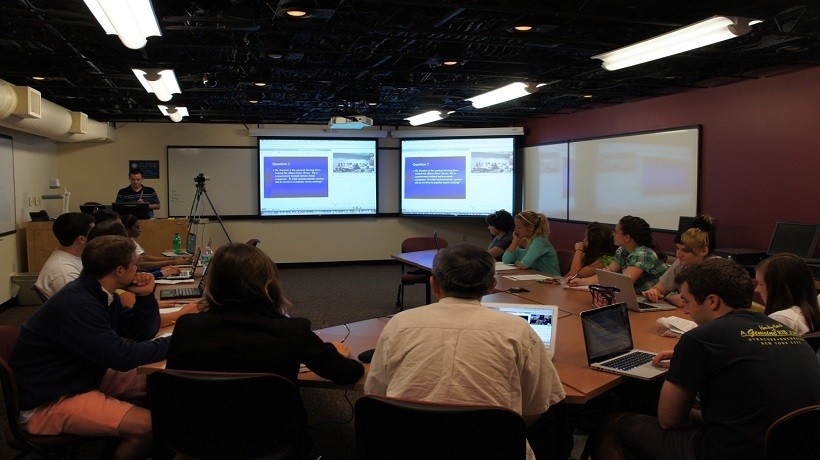Facts On Blended Learning And Tips Instructional Designers Will Find Useful
In the space of eLearning, there seems to be an endless revolving door of trends. Every few months, another buzzword captures the attention of the community of Instructional Designers and developers. Blended learning, spaced repetition, gamification, microlearning, design thinking, Augmented Reality/Virtual Reality, user-generated content, embedded learning – the list goes on and on.
Typically, each of these topics becomes buzzworthy for good reason. Someone sees potential value in the implementation. Someone sees how this new method will help us improve learner satisfaction, change performance, drive ROI. But, it seems inevitable that just as quickly as the concept arrived on the scene, the naysayers arrive.
We become filled with doubt, not wanting to appear to be bandwagoners. The critics give us counter arguments for moving forward. And so, we stop. We avoid the risk. We sacrifice potential to avoid the risk. Without even genuinely evaluating whether a particular solution works for us, given our unique organization, our unique employee set, our unique business challenges – we revert.
So, we stick with what is safe. We rely on the tried and true. We go back to what we know – a traditional, text and next eLearning course. Sure, we might make a few cool interactions. Maybe we use an improved UX. But the formula remains the same. We share content, learners consume content, we ask learners questions, learners answer questions and, subsequently, we hope the learners see enough value in the content to change behavior.
But, what if we moved away from a "fad" too quickly? What if there was real potential value in the solution? The value we’re missing out on because we allowed fear to stand in our way? What if we could improve our learning tomorrow by using techniques that seem so... yesterday?
Over the next few articles, I’m going to re-examine a number of fads/buzzwords in learning that I believe can add great value to your learning design. We’ll kick it off in this article with an exploration of blended learning, then move to gamification and finally to a recent trend, predictive learning.
What Is Blended Learning?
At its core, a blended learning program takes several modalities of delivering and combines them together into a program of instruction. Some organizations call them curricula, some call them learning paths, or maybe learning journeys. Whatever the name, the key to a blended learning program is that it "blends" modalities – how the learner receives the content or instruction. This may include an eLearning module, a classroom session, a virtual instructor-led webinar (or replays of such) – or even a TED talk, podcast, YouTube video, a book or an article, a group assignment or an assessment, a mentoring or job shadowing opportunity, etc. Whatever means in which your learners can try, fail, ponder, assess, and grow can be included in your blend.
Blended learning programs, when well executed, offer learners the benefits of spaced repetition, a potential for social connections and the guidance of feedback from a knowledgeable expert. However, when not thoughtfully designed, blended learning programs can feel disjointed, frustrate learners, and waste valuable time and effort.
So, when does it make sense to blend? What is the right blend? How do you blend? Well, as is often the case, the answer is… it depends. Unfortunately, there is no magic formula or algorithm (yet!) to create a well-designed blended learning program. That’s our job, as Instructional Designers. We work, like artisans, to craft a blend that is best suited for the learner audience (and organizational) needs.
But, even though your blend will be unique to your learners’ needs, there are some best practices to help you in your design. The key to designing an effective blended learning program is choosing the right modality.
To choose the appropriate modality, first, separate the "know content" from the "do content". For each topic, ask if this is something a learner needs to know or something they need to do. The "need to know" can be categorized in the information sharing delivery mode bucket, while the "need to do" falls into an application bucket. Below are descriptions of each:
Information – When Learners Need To Know
When information needs to be shared with learners, choose methods of delivery which are reachable and repeatable. For this reason, avoid using eLearning or an Instructor-Led Training to share information. Imagine trying to find the specific keystroke shortcut that was given to you on a slide in a one-hour eLearning program. It’s a needle in a haystack!
Instead, when you need to give your learners information, choose to deliver the content on intranet portals, web pages, videos, SharePoint sites, and printed or downloadable documents. The key for sharing information is to provide learners with an easily accessible source to quickly find the information they need, at the moment of need.
But, just because someone has given information to someone does not mean they will come. This isn’t the Field of Dreams, after all. When you share information, you should also provide your learners with a context by which they can understand how and when to use the information. An effective way to do this is through scenario-driven worksheets (printed or online) in which learners must use the information provided to answer the questions.
Are you sharing information on company history? Create a scenario where an employee is asked about his company by his neighbor. Providing product features and benefits? Have learners research and choose a first, second, and third match of product based on a customer’s need. Providing technical information? Have learners offer a solution to a mock coworker who has received an error message.
This technique is a different spin on the "typical" scavenger hunts or multiple-choice tests because it goes beyond finding the content and allows the learner to see why the information is valuable, and how they might use it in their world.
Application - When Learners Need To Do
When learners need to do something, focus your delivery modality on those which offer practice and skill building. Application modalities include eLearning, Instructor-Led Training (ILT), on-the-job activities, mentoring and action planning worksheets/coaching.
In eLearning, help learners apply knowledge and skills by designing scenario or challenge-based learning moments that provide the opportunity to try something and succeed, or fail, in a safe environment. Give real-world consequences for what success and failure will look and feel like.
If you are given the chance to get everyone together for an Instructor-Led Training event, appreciate what a valuable opportunity you have! It’s difficult, expensive, and rare to bring people together these days, so take full advantage of that moment by using the time together wisely. Don’t waste time sharing information that is better delivered in another format. Design the course so that learners can have an opportunity to get answers to real-world questions and input from the expert – and peers in the room.
The Right Blend
Once you have selected your delivery modality for each topic, how do you mix it together to make the right blend? The key is in the timing. All too often, we try to cram all the training into a very condensed period of time. New hire training is probably the biggest culprit of this offense. In reality, though, there are likely stages or gates that a learner should be able to pass through.
Ask the question to your organization leaders – what does success in the job look like? Who is fully trained and successful in their role? Then, ask them – how long did it take to reach this level of proficiency? Based on the complexity of the job, you may hear answers as long as several years. But along the way, there are milestones – time to productivity, time to competence, and then time to proficiency. Use those to determine which topics learners must be competent in and by when.
Scaffold the training to build upon existing knowledge, moving from awareness to competence to mastery. For example, when you do get the (increasingly rare) opportunity to get everyone together for a training event, create a blend that builds up to the event and continues after it ends. Provide pre-work to plant a seed, spur some thought, and challenge assumptions. In class, offer discussions, role-plays, case-studies, or group exercises. Then, offer post-training support and continued exploration of concepts discussed in class. This is a great time to use mentor programs, cohort discussion boards, suggest further reading or videos, and assess post-course evaluations of performance.
Remember, whatever blend you create, avoid designing in a vacuum. Get to know the target population and design with them by your side. All too often, learner engagement tanks from the start of a blended learning program because participants don’t feel the content is relevant to them. They need to be motivated to learn. They need to see how this program, and each component in the program, can help them be successful in their job.










